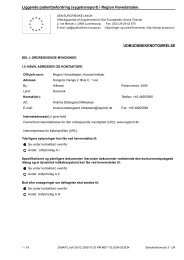Territorial Review Copenhagen - Region Hovedstaden
Territorial Review Copenhagen - Region Hovedstaden
Territorial Review Copenhagen - Region Hovedstaden
You also want an ePaper? Increase the reach of your titles
YUMPU automatically turns print PDFs into web optimized ePapers that Google loves.
95<br />
rising sea levels (which could rise by 40 to 130 centimetres by 2100) could<br />
have an amplitude of 190 to 280 centimetres above the current mean sea<br />
level. One recent team estimated that an increase of 50 centimetres in the<br />
water level over the next 50 years would cause total losses amounting to<br />
EUR 2.0 billion. 43 These economic losses, though significant, would remain<br />
manageable by the local economy and are not comparable to the level of<br />
devastation of a Katrina-like event, whose likelihood in <strong>Copenhagen</strong> has a<br />
probability largely below 1 out of 1 000 years (Hallegatte et al., 2008). The<br />
last flood in <strong>Copenhagen</strong> occurred in 1872. 44<br />
<strong>Copenhagen</strong> is renowned for being the ―City of Cyclists‖, due to its<br />
large number of cycle tracks and high bicycling rate. With a cycle track<br />
network of over 300 kilometres, the City of <strong>Copenhagen</strong> has invested<br />
considerably in improving cycling conditions. For example, in 2002, onethird<br />
of the budget for road construction was earmarked for cycle tracks,<br />
reinforced cycle lanes, and the opening of new routes (City of <strong>Copenhagen</strong><br />
Cycle Policy 2006-2012, 2002). Although some smaller and medium-sized<br />
cities in Europe, such as in Groningen or Münster, sometimes have higher<br />
percentages of bicycle use, among large OECD cities, <strong>Copenhagen</strong> has one<br />
of, if not the highest, rates of bicycle use. In 2006, 36% of <strong>Copenhagen</strong>ers<br />
bicycled to work, and the City of <strong>Copenhagen</strong> is attempting to raise this to<br />
50% (City of <strong>Copenhagen</strong>, Bicycle Account, 2006). In addition,<br />
<strong>Copenhagen</strong> can also pride itself on a considerable percentage of trips made<br />
by walking, although relatively low in comparison with the benchmark cities<br />
(Figure 1.31). As there are concerns about comparability of the data on this<br />
subject, Figure 1.31 must be interpreted with caution. Moreover, data on<br />
many cities are lacking, but it seems that this can be explained by the<br />
marginality of bicycles in the modal splits in these cities. One can assume<br />
with some certainty that the metropolitan areas in Figure 1.31 are at the<br />
forefront as regards bicycle use.

















